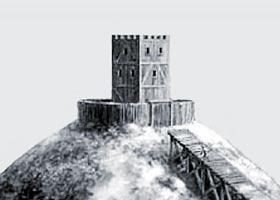Motte and Bailey Castles - The Meaning and Origin of the word 'Donjon', Dungeon and 'Keep'
The word 'donjon' originally described the keep or the tower which was built on top of the motte. The word 'Donjon' was derived from a Latin word meaning 'Dominating Point'. Later the word 'Donjon' was changed to 'Keep'. The word 'Keep' means "that which keeps or protects - the strongest and securest part of a castle, often used as a place of residence by the lord of the castle". The word 'Keep' also means "To hold, not to let go of, to retain in one's power or possession". The term 'Donjon' was not lost - it was a derivative for the word 'Dungeon' - the Nobles moved from the towers to more easily accessible living quarters and important prisoners were held in the 'donjons'. As time passed these towers for prisoners ceased to be built and prisons were built below ground level - the dungeon! The Purpose of the Motte and Bailey Castles
The purpose of the Motte and Bailey Castles were as follows: - Motte and Bailey Castles acted as a fortified post
- Motte and Bailey Castles provided a base where men, provisions and horses could be housed
- Motte and Bailey Castles were used to overawe and frighten the indigenous population
- Motte and Bailey Castles provided a base from which the Normans could govern the surrounding district
Attacking Motte and Bailey Castles!
Attacking a Motte and Bailey Castle took courage! The attackers would have to negotiate the following defences: - Constant attack from projectiles - arrows and stones etc
- Negotiate the outer ditch and embankment
- Storm the gate
- Negotiate the defences within the Bailey
- Climb, or crawl up, the embankment of the Motte - these were extremely steep and designed so that a horse could not climb it
- Take the gate of the Motte
- Storm and capture the Tower
The most successful form of attack on Motte and Bailey Castles was fire! The timber buildings would burn easily. The other form of attack would be to lay siege to the Motte and Bailey Castle. Defending Motte and Bailey Castles
The Motte and Bailey Castles were used as a fortified post for the Calvary to keep order in the surrounding areas. The castles were intended to intimidate the local population - just the appearance of such a structure resulted in capitulation by the local population. Should a castle be attacked the success in defending the Motte and Bailey Castles depended on how well the castle had been built - the height and the building materials. Their weapons - the number of arrows and the number of soldiers as opposed to the attacking force. Whether the Motte and Bailey Castle could withstand a siege - was there enough food and was there a supply of fresh water? Life in the Motte and Bailey Castles
The Normans were the victors - the invaders of the English Anglo Saxons. Life for the Normans was good. Their successful invasion of England meant wealth for the Norman invaders. Lands were divided between Norman Lords and they built the Motte and Bailey Castles. Life in the Norman Motte and Bailey Castles depended on the rank of the people who inhabited the castle. The Lord of the Castle and possibly his family would live in the most protected part of the castle - the Tower or the Keep. Servants would be expected to provide food for the Nobles and soldiers. The Soldiers were well paid and lived within the Bailey of the castle. Other occupations within the castle were the Blacksmiths - to keep a supply of arrowheads, the Stable hands to help with the horses and the kitchen staff. The Norman Motte and Bailey Castles
So started the strategy of the Normans to build Motte and Bailey Castles as their source of power in England. They initiated a programme of constructing more and more - it is believed that nearly one thousand Motte and Bailey Castles were built which were used by the Normans to totally subjugate the English and the Welsh. The scenes illustrated on the Bayeux tapestry, celebrating the Norman victory at the Battle of Hastings, and the eye witness accounts of the chroniclers has provided us with a vast amount of information about the Motte and Bailey castles. We recommend the following site for further details: The Battle of Hastings - 1066.The wooden Motte and Bailey Castles were gradually improved and the great fortresses of Medieval England - the great Norman Medieval stone Castles were built, ending the era of the Motte and Bailey. Norman Pre-Built Timber Castles
Motte and Bailey Castle Layout
Motte and Bailey Castles - Attack & Defence
Famous Motte and Bailey Castles
Life in a Motte and Bailey Castle
Norman Medieval Stone Castles
Norman Castles
Norman Castle Keep | 
